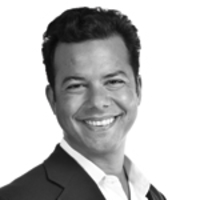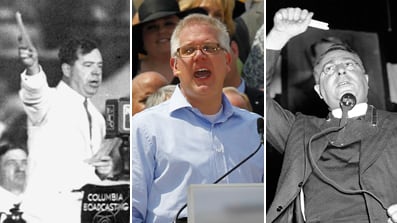Demagogues always do well in economic downturns.
A look through American history shows that divisive populist appeals during times of economic anxiety have a long history. They have come from politicians or media figures, hammering home their point on a soapbox or over radio waves. Now via satellite they can reach every home, but their appeal is always the same: promising followers solutions to all their problems by providing someone to blame. It is an “Us against Them” vision of America.
Gallery: America’s 9 Worst Demagogues

Ours is not the first time “the paranoid style in American politics,” as Richard Hofstadter famously called it, has reared its head. We’ve seen these faces and forces long before the likes of Glenn Beck.
• Conor Friedersdorf: Glenn Beck’s Online FlopThe Know-Nothing Party of the 1850s was anti-immigrant and anti-Catholic while waving the American flag, ultimately dubbing itself “the American Party.” During Reconstruction, politicians and marauding citizen militias imposed segregation on post-slavery South. President Theodore Roosevelt coined the term “lunatic fringe” to describe the violent anarchists in his day who assassinated his predecessor William McKinley.
During the Great Depression, divisive demagogues like Huey Long on the left and Father Coughlin on the right were hugely popular. Anger at the bankers who acted like gangsters and earned the term “banksters” became the focus of Main Street outrage.
They surfaced again in the paranoid anti-communism of Joe McCarthy and the John Birch Society. Wingnuts were flapping their wings when far-left liberals got all misty-eyed talking about “Uncle Joe” Stalin. In the ’60s, pro-segregation White Citizens Councils in the South pushed citizens’ “massive resistance” to desegregation while far-left radical groups like the Black Panthers responded with violence in the name of a very selective vision of “the people.”
Each of these groups were influential in their time and capable of intimidation. Each time, America beat them by standing up and calling out their paranoia, hate, and political excess. They shrank back into the shadows when confronted by the common sense and common decency of the moderate majority of the American people.
They air emotional grievances, articulate anxieties without ever posing practical solutions.
Racial and ethnic divisions are often exploited, as well, allowing people to blame the “other” for their inability to get a job, identifying a group of people as a symbol of the change they’re afraid of—and which seems to be taking their idealized old America away from them. Hate is a cheap and easy recruiting tool, but it can be murder on democracy.
“The only thing new in the world is the history you don’t know,” Harry Truman once said. The study of history can offer perspective on our problems today. Here’s the good news: We have faced down forces of demagoguery before. The damage they do can be limited by our determination to call them out, standing up to extremes wherever we see them, stopping the politics of incitement before it leads to something ugly and indelible.
John Avlon's new book Wingnuts: How the Lunatic Fringe Is Hijacking America is available now by Beast Books both on the Web and in paperback. He is also the author of Independent Nation: How Centrists Can Change American Politics and a CNN contributor. Previously, he served as chief speechwriter for New York City Mayor Rudy Giuliani and was a columnist and associate editor for The New York Sun.






